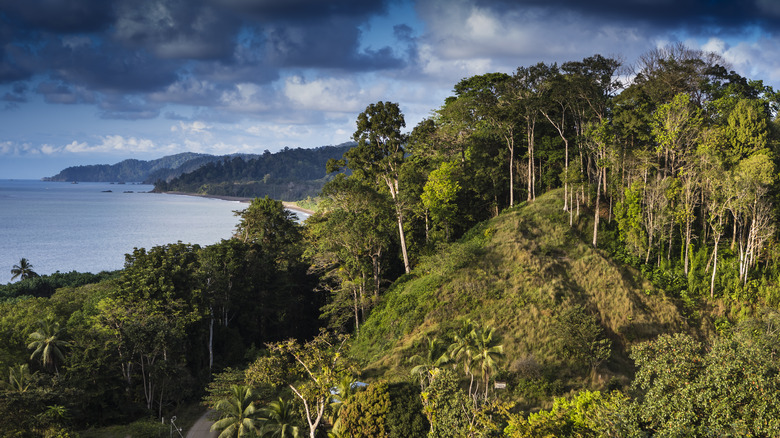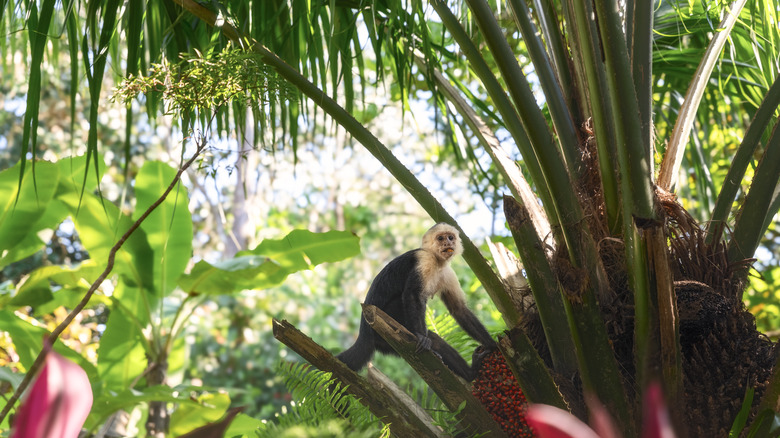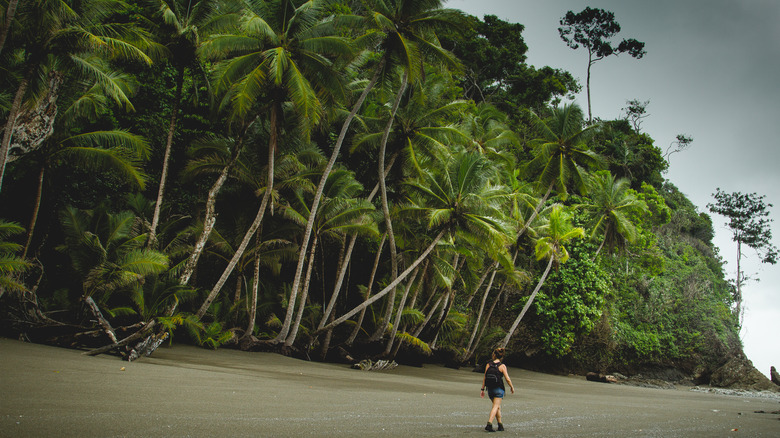This Pristine Costa Rica National Park Is One Of The World's Most Biodiverse Destinations
Costa Rica's remote Osa Peninsula is home to what could arguably be the crown jewel of the country's impressive national park system: Corcovado National Park. Spread over 161 square miles, the park includes an almost bewildering range of breathtaking landscapes, including low-altitude cloud forests, mangrove swamps, rivers, lagoons, and nearly 50 kilometers of sandy beaches. In short, it's a nature lover's paradise.
But perhaps more stunning than the park's geography is its biodiversity — more than 1 million plant and animal species call this place home. What makes this even more remarkable is the fact that, until the park's establishment in 1975, it was covered in farmland. Almost unbelievably, the Osa Peninsula contains roughly 2.5% of the world's biodiversity, according to The Guardian, despite accounting for just 0.001% of its landmass. As such, the park is a pristine example of the natural world's resilience when given a chance to flourish.
Taken together, this means the park is far more than simply an exotic holiday destination featuring some of the best beaches in the world. It's an immersive journey into one of the planet's remaining untouched ecosystems during a time when biodiversity and habitat loss are at an all-time high.
Corcovado's unforgettable wildlife watching
For those passionate about wildlife, Corcovado National Park offers some of the best animal-watching in the world. Its dense jungles and diverse habitats contain a staggering array of animals and plants that will catch the eye of both seasoned and novice nature photographers. The park is home to the country's most significant remaining population of tapirs, for example, and there are literally too many species present in the park to comprehensively list: Frogs, snakes, armadillos, anteaters, spider and howler monkeys, ocelots, and pumas all inhabit the area.
One of the highlights of visiting Corcovado is the chance to spot the elusive jaguar, one of the park's most iconic residents. Sightings are rare but rewarding and held in exceptionally high regard by the region's indigenous Boruca people, who consider the jaguar to be a symbol of the culture's warrior spirit. More common animal sightings include spider monkeys that swing through the 500 species of trees above. Bird-watching enthusiasts won't be left wanting either. The park's diversity is impressive, being a haven for more than 400 bird species, including Scarlet Macaw, Great Black Hawk, and Striped Owl.
Marine and semi-aquatic species are worth keeping an eye out for, too. Humpback whales and spinner dolphins are known to pass through the Pacific waters that surround the park, and crocodiles and caiman can be seen on the shores of its myriad rivers. Overall, the park is a wildlife refuge, rivaling even the most mesmerizing national parks in the Caribbean.
Hike Corcovado's lush trails
The best way to see the range of wildlife Corcovado has to offer is on foot (and with a solid pair of hiking boots). Visitors can take guided hikes from one of four ranger outposts in the park, and two of the more popular points of entry to the park are at San Pedrillio and Sirena ranger stations. The La Leona-Madrigal trail is a good place to start for those looking for a long but only moderately challenging hike. The 6-mile trail takes you along a coastal route and serves up some dramatic views of the ocean.
For those seeking a more intense adventure, the Los Patos-Sirena trail takes hikers deep into the rainforest and, as such, is a more demanding walk. The dense jungle path covers 12 miles and takes an average of about 6 hours to complete, so make sure you take proper footwear and plenty of water with you. If you're going solo, you should freshen up on the best safety tips to know before your first hike, too.
When feeling especially motivated, you can try taking the trail from La Leona to La Sirena. You're unlikely to encounter many other people on this 11-mile hike, which includes river and beach crossings, some mildly challenging climbing, and, of course, plenty of wildlife. The hike can take upwards of 7 hours to complete and involves some genuinely rigorous sections, so go with a guide to ensure your safety.


